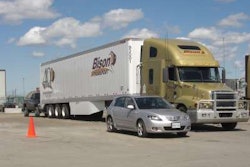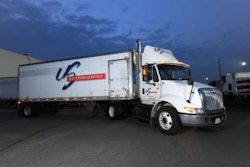View the PDF of the CCJ Top 250.
Based on the top line, 2008 wasn’t a horrible year for North America’s top for-hire trucking companies, but the top line includes record-high fuel surcharges. With freight soft and costs high, many shed trucks and drivers but kept rolling.
If you look only at the gross revenue numbers for North America’s 250 largest trucking companies, 2008 didn’t seem like such a bad year. Among those for-hire carriers for which revenue numbers were available to CCJ, total revenue rose 3.9 percent – not a great year by any stretch, but certainly not clearly disastrous. Without behemoths UPS and FedEx, whose scope tends to skew the results in the CCJ Top 250, trucking companies still eked out a 2.9 percent gain.
Unfortunately, most trucking companies wrap their fuel surcharges into total revenues. So when you consider that diesel prices averaged a third higher in 2008 than in 2007, the meager revenue gains for 2008 begin to appear far from healthy.
Indeed, you get a much better picture of what happened in 2008 – and continues in 2009 – by looking at the power unit and driver situation. Accurate year-over-year comparisons are difficult because much of the CCJ Top 250 equipment and driver data is based on government records that aren’t necessarily updated each year. Still, you can see the trend. Isolating just those carriers that were in the CCJ Top 250 in both 2008 and 2007, the number of straight trucks and tractors dropped 5.8 percent, and the number of drivers declined 1.1 percent. Excluding UPS and FedEx, the Top 250’s power unit fleet declined 7.5 percent, and the number of drivers dropped 5.1 percent from 2007.
Remarkable perseverance
But while many big fleets downsized, surprisingly few failed last year. No doubt, one factor – especially for truckload carriers – was the rollercoaster ride of diesel prices. If a carrier somehow managed to make it to the fall when the rest of the economy seemed near collapse, its near-term prospects were good largely because of the lag between booking surcharges and receiving them. Plummeting diesel prices in the second half of the year acted to boost cash flow.
The largest outright failure from last year’s Top 250 appears to be Chesterton, Ind.-based Priority Transportation, which ceased operations in September 2008. Priority had ranked No. 133, having slipped from No. 96 the year before. In addition, two major carriers – Performance Transportation Services and Jevic Transportation – had failed in 2008, but both occurred before last year’s CCJ Top 250 was published.
There have been some consolidations, however. For example, major bulk conglomerate Kenan Advantage Group – No. 36 in this year’s CCJ Top 250 – in 2008 absorbed Transport Service Co., which had ranked No. 149 last year. The acquisition no doubt was a big factor in Kenan’s 29.4 percent jump in revenues in 2008 compared to 2007. Vision Logistics Holding – a unit of private equity firm Welsh Carson Anderson and Stowe – joined together major heavy-haul players Ace Transportation and Venture Transport Logistics as well as their smaller affiliates Dynasty Transportation and Texas Hot Shot. Ace and Venture had ranked No. 60 and No. 80, respectively, in last year’s CCJ Top 250. This year, Vision Logistics Holding debuts at No. 28.
The usual suspects
Taking into account the effect of fuel surcharges on revenue, the relative performance of industry segments fall fairly well in line with expectations. Given the state of the housing market, you would expect household goods carriers to have had the hardest time, and you would be right. Revenue for household goods carriers reporting it collectively fell 4.6 percent. Likewise, motor vehicle sales remain weak, and the several vehicle haulers reporting results posted a mere 1.6 percent gain.
Most other trucking companies that depend substantially on demand for consumer goods – less-than-truckload, package and dedicated carriers, for example – posted weaker revenue gains than those with significant industrial clientele or more stable demand curves, such as bulk, heavy haul and refrigerated products. The LTL segment’s performance is somewhat misleading, however. While as a group LTL carriers posted a slim 1.8 percent increase over 2007, the numbers were depressed significantly by troubled LTL giant YRC, which saw revenues dip 7.1 percent last year. Excluding YRC, LTL carriers posted 7 percent higher revenues in 2008.
With perhaps the most diverse freight in the industry, truckload general freight carriers posted revenues that were 6 percent higher than in 2007, coming in between the best and worst performers.
While 2008 wasn’t much to write home about, the steps trucking companies have taken in downsizing their operations could serve them well by keeping capacity in check, at least for a while, once the economy does rebound. The question is: When will that be?












